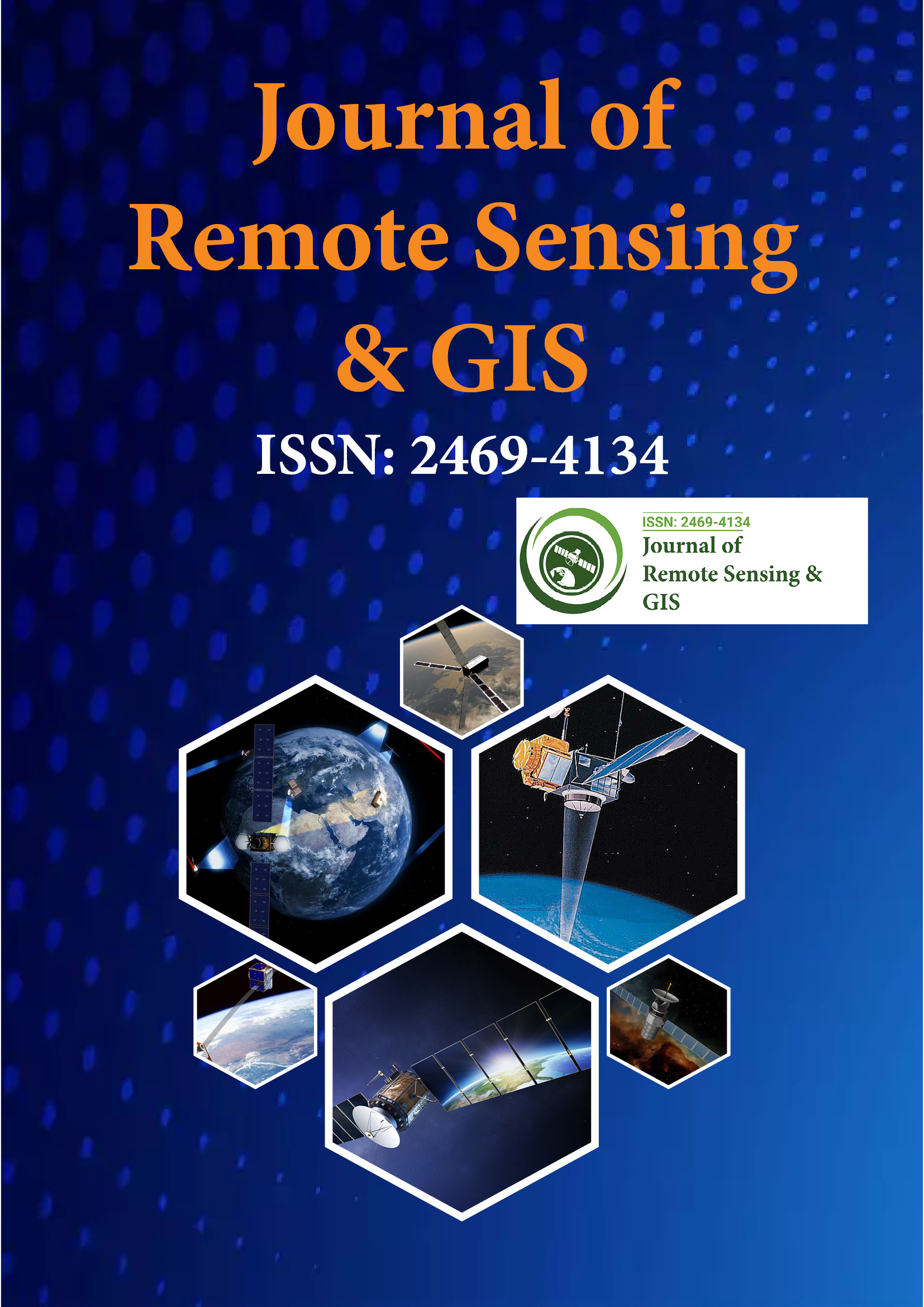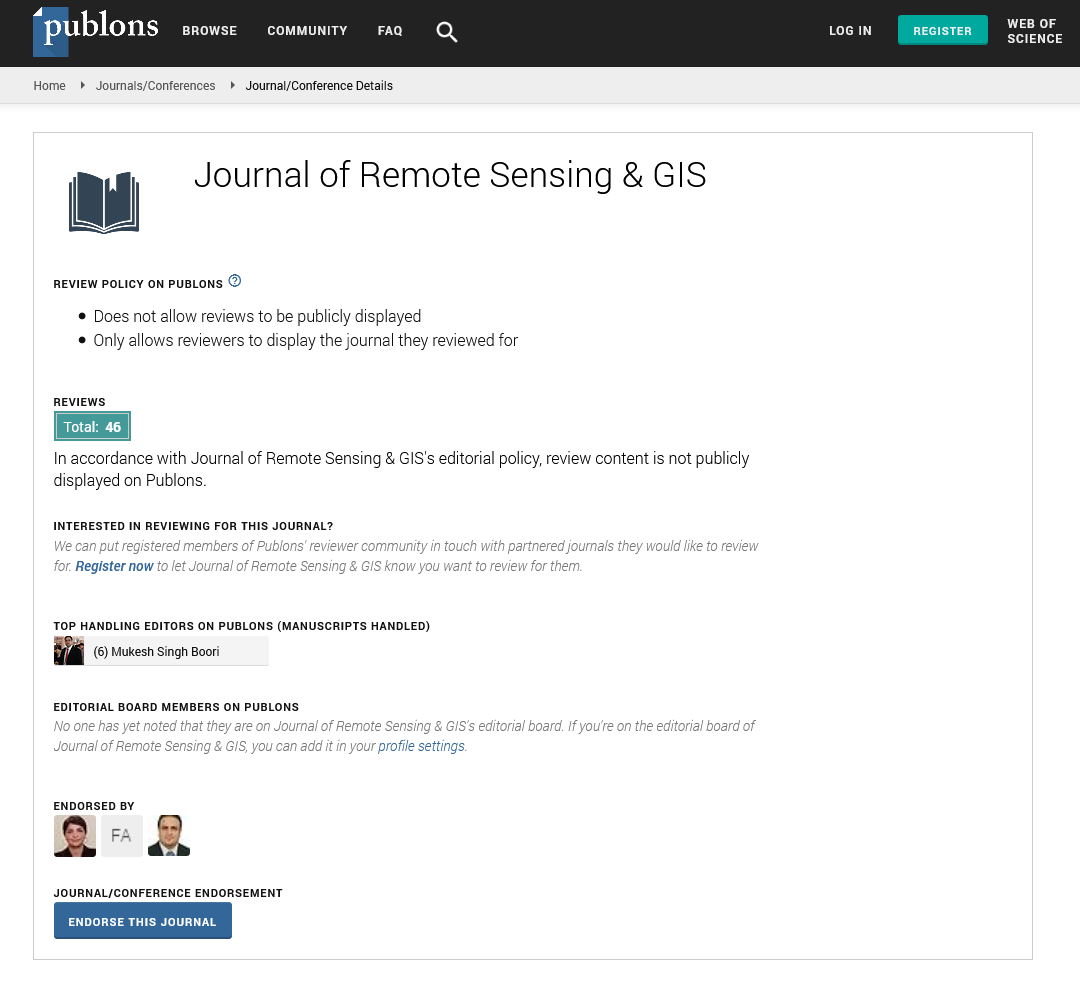Indexed In
- Open J Gate
- RefSeek
- Hamdard University
- EBSCO A-Z
- OCLC- WorldCat
- Publons
- International Scientific Indexing
- Euro Pub
- Google Scholar
Useful Links
Share This Page
Journal Flyer

Open Access Journals
- Agri and Aquaculture
- Biochemistry
- Bioinformatics & Systems Biology
- Business & Management
- Chemistry
- Clinical Sciences
- Engineering
- Food & Nutrition
- General Science
- Genetics & Molecular Biology
- Immunology & Microbiology
- Medical Sciences
- Neuroscience & Psychology
- Nursing & Health Care
- Pharmaceutical Sciences
Commentary - (2025) Volume 14, Issue 1
Advances in Remote Sensing Satellite Systems and Their Applications in Geospatial Analysis
Mohammed Imam*Received: 25-Feb-2025, Manuscript No. JGRS-25-28686; Editor assigned: 27-Feb-2025, Pre QC No. JGRS-25-28686 (PQ); Reviewed: 14-Mar-2025, QC No. JGRS-25-28686; Revised: 21-Mar-2025, Manuscript No. JGRS-25-28686 (R); Published: 28-Mar-2025, DOI: 10.35248/2469-4134.25.14.372
Description
Remote sensing satellites have transformed the way we observe and analyze the earth's surface. These satellites carry instruments that detect and record information about the planet from orbit, offering consistent, wide-scale and multi-temporal data collection. From environmental monitoring to resource management, urban planning and disaster assessment, remote sensing satellites play an increasingly important role in a broad range of scientific and practical applications.
Principles of remote sensing
Remote sensing involves the acquisition of information without direct physical contact. Satellites equipped with sensors detect electromagnetic radiation reflected or emitted from the Earth’s surface. These sensors operate across various parts of the spectrum, including visible light, infrared, microwave and thermal bands. By interpreting the spectral signatures of land, water, vegetation and built environments, scientists can extract meaningful patterns and insights.
There are two primary types of sensors used in remote sensing:
• Passive sensors detect natural energy that is reflected or emitted by the Earth, such as sunlight or thermal radiation.
• Active sensors emit their own energy (such as radar or LiDAR) and measure the signal reflected back from the surface.
Types of remote sensing satellites
Remote sensing satellites are often categorized based on the type of sensor they carry and their orbital characteristics. The two most common orbits are:
Sun-synchronous (polar) orbits: These satellites pass over the same region at the same local solar time, ensuring consistent lighting conditions. They are used for environmental monitoring, agriculture and land use mapping.
Geostationary orbits: These satellites remain fixed above a particular point on the equator, offering continuous coverage of a specific region. They are ideal for weather monitoring and communication services.
Depending on their payloads, satellites can further be classified as:
Optical imaging satellites (e.g., Landsat, Sentinel-2): Use visible and near-infrared sensors to capture surface imagery.
Radar imaging satellites (e.g., Sentinel-1, RADARSAT): Use synthetic aperture radar (SAR) to detect surface features through cloud cover and at night.
Thermal imaging satellites (e.g., MODIS on Terra/Aqua): Measure surface temperature and heat emissions.
Hyperspectral satellites (e.g., EnMAP, PRISMA): Capture hundreds of narrow spectral bands for detailed material identification.
Major remote sensing satellite missions
Several satellite programs have contributed significantly to earth observation:
Landsat program (USA): Operational since 1972, Landsat satellites have provided continuous multi-spectral data on land cover and land use changes across the globe.
Sentinel series (ESA-Copernicus program): Sentinel-1 (SAR), Sentinel-2 (optical) and Sentinel-3 (ocean and land monitoring) are part of the European Union’s initiative for long-term environmental monitoring.
Terra and aqua satellites (NASA): Equipped with MODIS sensors, these satellites collect data on vegetation, climate, ocean color and atmospheric properties.
RADARSAT (Canada) and COSMO-SkyMed (Italy): These radar satellites are used extensively for flood mapping, ice monitoring and surface deformation studies.
Indian Remote Sensing Satellites (IRS): Deployed by ISRO, these satellites support agriculture, forestry, water resources and urban development applications.
Applications of remote sensing satellites
Remote sensing data from satellites serve a wide range of sectors:
Agriculture: Satellite imagery helps monitor crop health, estimate yield, track drought conditions and guide precision farming practices. Vegetation indices such as NDVI (Normalized Difference Vegetation Index) provide insights into biomass and plant vigor.
Forestry: Deforestation, afforestation, forest fire damage and biodiversity studies are all supported by satellite-based data. High-resolution time series enable forest change detection over time.
Water resource management: Satellites detect surface water bodies, track river flows and monitor changes in snow and glacier coverage. Microwave sensors can penetrate cloud cover to monitor soil moisture and flood extents.
Disaster management: In the aftermath of floods, earthquakes, or hurricanes, satellites provide timely imagery for damage assessment, logistics planning and recovery operations. Radar systems are particularly useful in cloudy or nighttime conditions.
Urban planning: City growth, infrastructure development and land use change are analyzed through high-resolution imagery. Urban heat islands and population density models also rely on satellite data.
Climate and environmental studies: Long-term climate observations require consistent and calibrated satellite datasets. Satellite-based measurements of sea surface temperature, greenhouse gases and vegetation cover support global climate models and environmental assessments.
Data access and processing
Many satellite data products are freely accessible through government portals. For example, NASA’s Earth data platform and ESA’s Copernicus Open Access Hub provide open access to data from Landsat, Sentinel and other missions. Tools such as Google Earth Engine, SNAP (Sentinel Application Platform) and QGIS help process and analyze remote sensing data efficiently. Cloud-based platforms have further simplified the use of large satellite datasets, enabling global-scale analysis without the need for high-end hardware or extensive data storage.
Future trends in remote sensing satellites
Recent developments point toward increased miniaturization and privatization in satellite deployment. Small satellites and constellations, such as those by Planet Labs and Maxar Technologies, provide daily high-resolution imagery, opening new opportunities for near real-time monitoring. Artificial intelligence and machine learning are being integrated into image analysis workflows to enhance pattern detection, classification accuracy and predictive modeling. Integration with Internet of Things (IoT) and ground-based sensors is also expanding the scope of satellite-based applications.
Conclusion
Remote sensing satellites provide essential data for observing and understanding the Earth across time and space. Their capacity to monitor dynamic processes such as vegetation growth, urban expansion and environmental change makes them an integral part of scientific research and resource management. As technology evolves, the range, resolution and accessibility of satellite data are expected to improve, further supporting data-informed decision-making across sectors.
Citation: Imam M (2025) Advances in Remote Sensing Satellite Systems and Their Applications in Geospatial Analysis. J Remote Sens GIS. 14:372.
Copyright: © 2025 Imam M. This is an open-access article distributed under the terms of the Creative Commons Attribution License, which permits unrestricted use, distribution and reproduction in any medium, provided the original author and source are credited.

